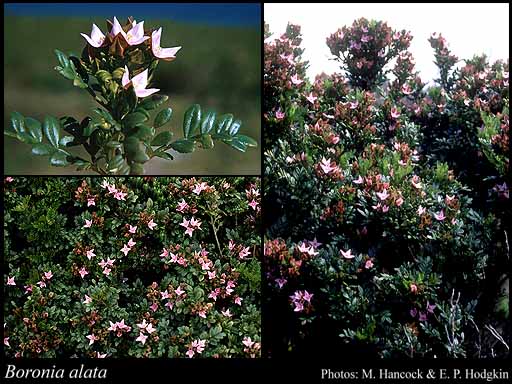- Reference
- Trans.Linn.Soc.London 8:283 (1807)
- Conservation Code
- Not threatened
- Naturalised Status
- Native to Western Australia
- Name Status
- Current
Upright, spreading shrub, 0.3-2(-3) m high. Fl. pink-white, Jul to Dec. Coastal sand & limestone. Dunes, cliffs.

Scientific Description
Shrub, spines absent; branchlets smooth, without distinct raised glands, winged or strongly angled in cross-section, covered in hairs or scales, the hairs simple. Leaves opposite, compound, 30-75 mm long, with 13-17 leaflets, each 7-18 mm long, 3-8 mm wide, flat, the margins flat, smooth, without distinct raised glands, glabrous; stipular excrescences absent. Flowers in axillary, loose clusters (cymes or panicles); pedicels 4-5 mm long; calyx present, 3.5-4 mm long, smooth, without distinct raised glands, glabrous except for a ciliate marginal fringe, the hairs simple or stellate (star-shaped); corolla pink or white or cream, petals four, 9-10 mm long, imbricate (overlapping), free, hairy on the surfaces or glabrous; stamens twice as many as petals, 1-1.5 mm long, smooth, hairy; anthers 0.5-0.7 mm long, without an appendage. Flowers in July, August, September, October, November and December. Occurs in the South-West Botanical Province, in the Jarrah Forest, Warren, Esperance and Swan Coastal Plain IBRA region(s).
Distribution
- IBRA Regions
- Esperance Plains, Jarrah Forest, Swan Coastal Plain, Warren.
- IBRA Subregions
- Fitzgerald, Perth, Recherche, Southern Jarrah Forest, Warren.
- IMCRA Regions
- Leeuwin-Naturaliste, WA South Coast.
- Local Government Areas (LGAs)
- Albany, Augusta Margaret River, Busselton, Cockburn, Cottesloe, Denmark, Esperance, Manjimup, Rockingham.